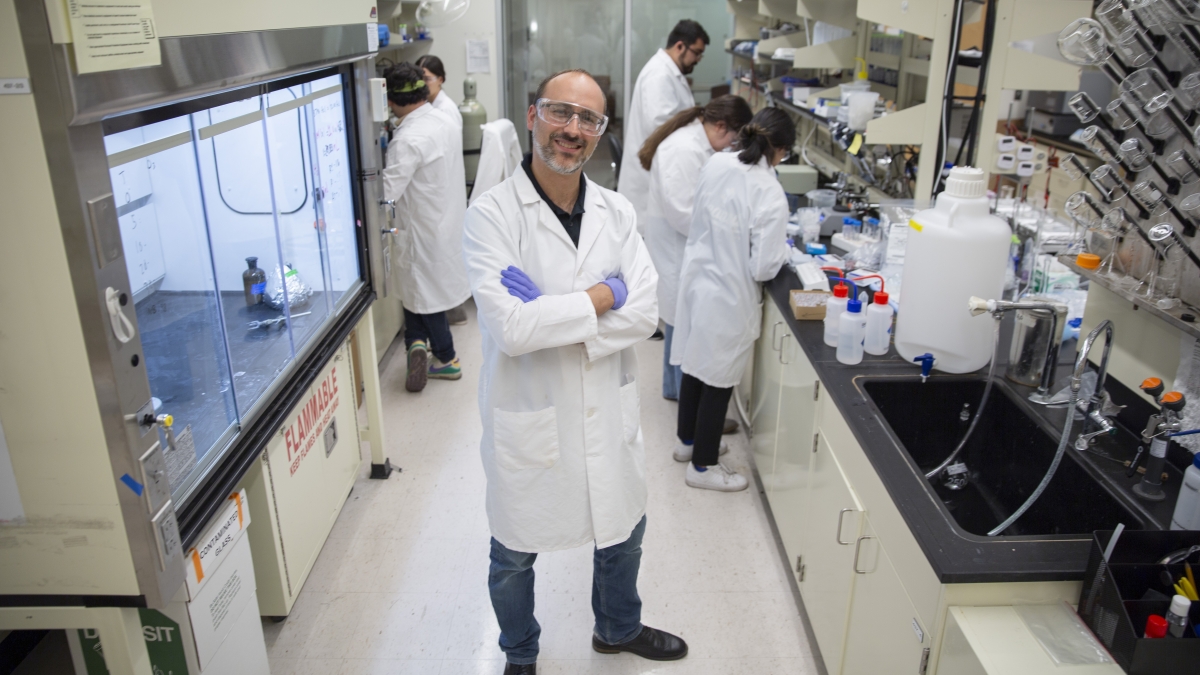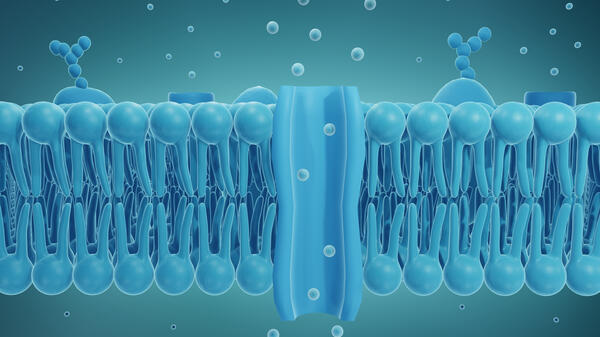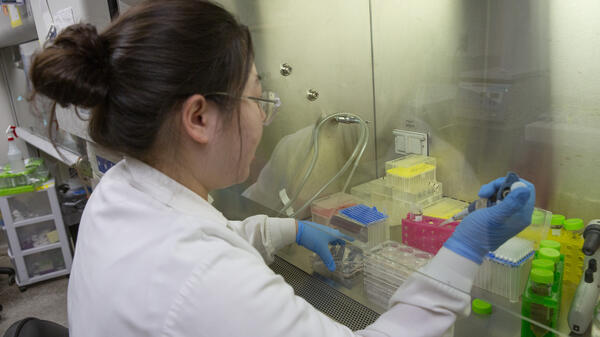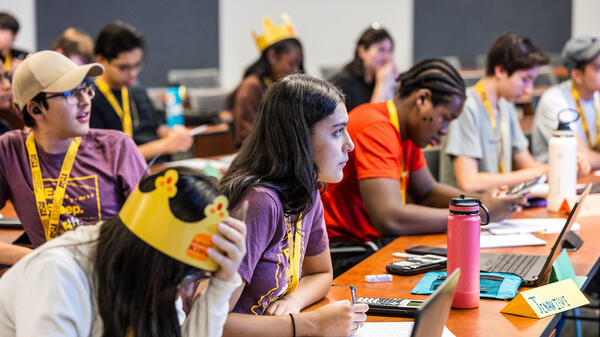Engineering equitable solutions for the food-water-energy nexus

Fulton Schools researcher Sergi Garcia-Segura is developing interdisciplinary solutions for accessible and equitable water treatment. Photo by Erika Gronek/ASU
The nexus of food, water and energy is the foundation of civilization and the focus of many global challenges that engineers and scientists are working to solve. This interconnected triad forms the basis of human survival and development, shaping economies, societies and the environment.
As the global population continues to grow and the impacts of climate change become more pronounced, ensuring sustainable and efficient management of these critical resources has never been more urgent. Environmental engineers are at the forefront of this challenge, devising innovative solutions to balance the growing industrial demands for food production, water supply and energy generation.
Sergi Garcia-Segura, an assistant professor in the School of Sustainable Engineering and the Built Environment, part of the Ira A. Fulton Schools of Engineering at Arizona State University, says that the three industries exist in tandem and rely on each other.
“When you start to look into issues with water, you quickly realize that there is an unbreakable link among energy, water and food,” he says. “Changing just one piece can have detrimental effects on the others.”
Garcia-Segura specializes in optimizing the cost and efficiency of water accessibility through the agriculture and energy industries. He uses interdisciplinary approaches to solve complex problems related to water quality and ecosystems. His mentorship, research contributions and innovative solutions have earned local and international acclaim from notable institutions.
“As a researcher, you have the opportunity to change processes and support initiatives that ultimately shape the future,” he says. “You have to be very intentional with your actions to generate real change.”
Integrating interdisciplinary understandings
Garcia-Segura’s research, education and perspective are inspired by his awareness that all disciplines and outcomes are interconnected.
“Water quality impacts the lives of everybody,” he says. “Not only people but also all living beings that are associated with ecosystems. All organisms depend on water.”
His interdisciplinary approach is fueled by his background in environmental, electrical, chemical and materials science engineering. He says that his chemistry background taught him to think in abstract terms, while his engineering degree kept him rooted in the real world.
Garcia-Segura’s education, which he earned at universities across three continents, fueled his global perspective and has empowered his commitment to advancing accessible water treatment. He built his career through the examination of the materials and methods used in industrial practices and how those materials eliminate pollutants from water.
As part of his latest research, Garcia-Segura is developing nanotechnology-based electrochemical processes that remove nitrates from water, a common pollutant from fertilizers and other anthropogenic activities.
“We want to remove these nitrates from water in a way that facilitates nitrogen cycle balance and is accessible worldwide,” he says.
Garcia-Segura is developing nanotechnology to modulate the tiny bubbles that naturally occur in water, known as nanobubbles, to aid in several water treatment applications. Nanobubbles can drastically change the water treatment landscape by enhancing the performance of gas-starved systems.
His research suggests that applying electrochemical processes can stimulate the surface area of the nanobubbles to facilitate chemical reactions that may improve water treatment and enable the recovery of valuable resources such as ammonia, which can be used as an energy source.
“We can drive selective transformations to produce alternative options,” he says. “The challenge is that those transformations can be extremely expensive. Our approach is unique because we exploit sustainable, Earth-abundant materials to perform selective transformations.”
His research on electrochemical technologies has received funding from the Bill and Melinda Gates Foundation, the American Chemical Society, the Bureau of Reclamation and the National Science Foundation.
Garcia-Segura is also exploring nanostructured gas-liquid interfaces. He has received funding from NASA to investigate whether nanotechnology processes can improve life support systems used during space missions and has also been recently funded to conduct experiments under microgravity conditions.
Back here on Earth, he is exploring the use of nanobubble technologies to control harmful algae blooms with the funding support of ASU’s Extreme Environments Science and Technology Center and the Arizona industrial partner Alarivean. More recently, his team has received funding support from the U.S. Bureau of Reclamation on the use of nanobubbles to prevent fouling and scaling of membrane processes.
Garcia-Segura’s work has received local and international acclaim. He was honored by the Spanish Royal Society of Chemistry as a group leader and young researcher for his contribution to environmental engineering, along with the 2023 Emerging Investigator Award from the Sustainable Nanotechnology Organization for his impact on sustainable nanotechnologies. He also received the Quentin Mees Research Award from the Arizona Water Association for his exceptional academic achievements and research that impact Arizona.
“Each honor recognizes the efforts I’ve made and its impact on different communities,” he says. “Getting recognition from different communities shows me that my work is interdisciplinary and moving progress forward.”
Aksana Atrashkevich, a civil, environmental and sustainable engineering doctoral student in Garcia-Segura’s lab, says working with the researcher expanded her perspective.
“I started asking more important questions about the core of what is happening in both science and life,” Atrashkevich says. “This shift has helped my confidence.”
Ram Pendyala, the director of the School of Sustainable Engineering and the Built Environment, says that Garcia-Segura’s dedication to excellence exemplifies the spirit of the school and reinforces the institution’s mission to make a positive impact on the world, both locally and globally.
“We are immensely proud of the groundbreaking work being done by Professor Garcia-Segura in nanotechnology-enabled water treatment. His innovative research addresses critical global challenges in water purification and sustainability.”
An ecosystem designed for all
Garcia-Segura’s commitment to enhancing water accessibility and innovation found a home at ASU through compatible values and research initiatives.
“The ASU ecosystem of innovation has a unique philosophy and mission that aligns with my vision for inclusion and providing opportunities to everyone,” he says.
Garcia-Segura and other ASU faculty collaborate with various partners across the state to develop methods for water conservation, augmentation, desalination, efficiency, infrastructure and reuse. His focus is on reducing the water footprint of crops to increase food production with less water in Arizona.
“Arizona is a very highly water-stressed community,” he says. “It’s not that we don’t have plenty of water, but how the water is shared and preserved has its challenges.”
Garcia-Segura’s nanotechnology methodologies have also been an asset to NEWT, the Engineering Research Center on Nanotechnology Enabled Water Treatment funded by the National Science Foundation. The center aims to encourage interdisciplinary collaborative research across the country to make clean water available to everyone, even in places that don’t have regular access to electricity or water systems.
“Electrochemical technologies have the potential to provide a unique opportunity to make water treatment and water quality more accessible for others,” he says. “Strengthening accessibility will empower the food-water-energy nexus and drive outcomes that will positively impact communities.”
More Science and technology

Chilling discovery: Cold-sensing protein may pave the way for safer pain relief
For millions of people worldwide who live with chronic pain, the only treatments currently available often rely on opioids, which carry the risks of addiction and overdose. However, new research…

Harnessing benefits of stem cells for heart regeneration
Mehdi Nikkhah, an associate professor of biomedical engineering in the Ira A. Fulton Schools of Engineering at Arizona State University, and his collaborators at Mayo Clinic in Arizona have been…

Newly accredited ASU summer program opens up STEM opportunities for underrepresented students
It was Monday afternoon. Spotify was playing pop music in the background and the instructor stood behind a lectern wearing a paper Burger King crown. It is not a scene one would expect in a college…